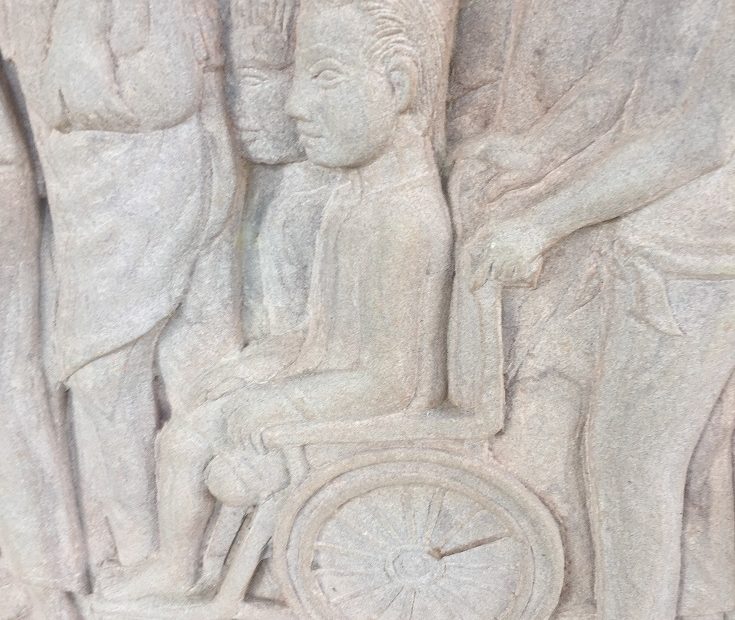What drives restraint in armed conflict? Recent studies have examined different factors contributing to restraint behaviour, mainly focusing on strategic incentives, such as seeking legitimacy from international audiences or securing support from local communities.
In this post, Henrique Garbino, Doctoral Candidate at the Swedish Defence University, and Matthew Bolton, Professor at Pace University, explore, instead, how traditional humanitarian norms protecting the innocent, the land, and the body may influence restraint on the use of landmines and similar explosive devices. They conclude that we should not perceive such norms as inadequate alternatives to international humanitarian law; instead, they may serve as a basis for extending global norms beyond the existing laws of war.
Restraint, understood as the self-limitation on the use of violence, is a topic of increasing interest among scholars and practitioners, as showcased in ICRC’s 2018 report, The Roots of Restraint in War. By better understanding the drivers and dynamics of restraint, this effort aims at identifying potential pressure points and engagement strategies to promote restraint norms in armed conflict.
There are different reasons why both State and non-State armed groups would choose to limit the use of violence. For instance, some scholars differentiate between mechanical, strategic, and moral restraint. Mechanical restraint entails the reduction of violence due to logistical and capability shortcomings, such as the lack of ammunition to continue an attack. Strategic restraint denotes the self-limitation on the use of violence due to strategic reasons and not the intention of reducing human suffering per se. For example, armed groups may choose not to kill civilians to exploit their work. Finally, moral restraint is guided by the moral imperative of reducing the human, social, economic, and environmental impact of armed conflict.
In this post, we are primarily interested in moral restraint in the use of force, which is largely – but not solely – codified in existing formal norms, such as international humanitarian law (IHL). This body of law is founded on norms that have roots and resonances in prior cultural and religious paradigms, such as conflict resolution norms in African customary law, the Arabic chivalric ideal, the Hindu code of Manu, as well as Muslim and Christian values.
We define ‘traditional humanitarian norms’ as cultural, religious, and philosophical norms that exist at the communal or societal levels but have not been codified into formal laws governing violence. Such informal norms may contradict, conform with, or even go beyond existing codified norms. Importantly, we extend the typical framing of local humanitarian norms as inadequate alternatives to, or pathways for, the implementation of IHL. As we will show, the mobilization around traditional humanitarian norms has contributed to setting new standards within IHL.
The case of anti-personnel mines
This post focuses on traditional sources of restraint on landmine use. We do so for four main reasons. First, the landmine issue has been primarily framed in moral terms and thus constitutes an excellent example of moral sources of restraint. For example, the language of the primary legal instruments dealing with landmines, namely the 1996 Amended Protocol II of the Convention on Certain Conventional Weapons and the 1997 Anti-personnel Mine Ban Treaty, emphasizes landmines’ indiscriminate effects leading to the suffering of ‘mostly innocent and defenceless civilians and especially children’; the superfluous nature of landmine injuries, causing unnecessary suffering even for enemy combatants; and ‘the role of public conscience in furthering the principles of humanity’ against the use of mines.
Second, landmines primarily affect already marginalized regions, where formal institutions of States and international organizations have less salience in politico-military decision-making. Further, despite recent use by some States, for the last decades, non-State armed groups have become the main users of landmines and the leading cause of new landmine contamination. Because such groups have arguably fewer incentives to comply with international law, we argue that traditional norms may be leveraged in promoting restraint, particularly on landmine use.
Thirdly, we acknowledge that several organizations appeal to traditional sources of restraint in their daily work while engaging non-State armed groups. Notable examples include ICRC’s broad engagement with religious leaders and faith-based organizations, specifically in the Gaza Strip and Sri Lanka. In addition, the Swiss-based NGO Geneva Call engages in direct advocacy and diplomacy with non-State armed groups to encourage them to commit to and comply with humanitarian norms, such as banning anti-personnel landmines. However, most studies on restraint on landmine use, in particular, still focus on strategic and mechanical restraint.[1] Thus, we hope to contribute to this still insipient debate.
Finally, we recognize the note of condescension underlying the idea that traditional humanitarian norms are somehow ‘off-brand’ alternatives to IHL in general and the Anti-personnel Mine Ban Treaty in particular. There is an assumption, not unlike ideas of imperial governance or counter-insurgency, of ‘using’ traditional norms to try to bend armed actors’ behaviour into compliance with the dominant global expectations. This hint at a ‘standard of civilization’ resonates with colonial powers’ use of IHL to normalize their violence and stigmatize that of societies they considered ‘barbaric’. Indeed, we wish to show that mobilization around traditional restraint norms in certain mine-affected countries actually contributed to the negotiation of new global norms on landmines, particularly regarding assistance to survivors.
Traditional sources of restraint on landmine use
We identify three main traditional sources of restraint on landmine use linked to protecting the innocent, the land, and the body.
Several cultural traditions highlight the moral imperative of protecting the innocent. The indiscriminate nature of landmines, however, more often than not, puts the innocent at risk. Thus, when combatants decide to use landmines, they accept the risk of civilian victimization for their own protection. This may challenge the warrior ethos and place the use of landmines as an act of cowardice, as put forward by Human Rights Watch in a 1991 report entitled The Coward’s War: Landmines in Cambodia. In other words, so-called ‘true warriors’ should face their enemies on equal terms and not put civilians in harm’s way in doing so. The Taliban stated in 1998 that the use of landmines was ‘an un-Islamic and anti-human act’, which ‘would be punished in accordance with Islamic Law’ due to its indiscriminate effects on ‘thousands of innocent Afghans, including women and children’.
Compared with other means and methods of warfare, landmines are unique to the extent that their effects are persistent and spatially bound. As such, landmine contamination may challenge notions of sacred land and communities’ relationships with nature and wildlife. Some societies in Cambodia, for example, believe that a ‘minefield might be haunted by dangerous spirits, particularly if someone had died there’. Likewise, in Myanmar, writes the anthropologist Tomas Cole, the potential presence of landmines ‘haunted, and indeed possessed a large swathe of land’.
Finally, the bodily damage caused by landmines (and other explosive devices) is directly linked to cultural aspects of disability, proper burial, and the afterlife. Some religious practices, for instance, encourage burial within a limited amount of time, which can be challenging in case of a casualty inside a minefield. Further, some traditions require the proper burial of the amputated limb, which might have been destroyed after the explosion. Early Christian theologians, for example, believed that, upon Resurrection, ‘the dead would rise with all and only the same matter as their bodies had had at the time of their death’. Thus, according to this belief, an amputee would remain an amputee in the afterlife. Of course, while such beliefs can contribute to stigma against mines, it may also extend to the bodies of those who have been disabled by landmine explosions. One must therefore be careful about mobilizing sources of stigma that may be used to oppress people with disabilities or facing other forms of marginalization.
When traditional norms extend IHL
The dominant narrative of the development of the Anti-personnel Mine Ban Treaty has often focused on the role of wealthy ‘middle powers’ like Canada, Norway, Sweden, Switzerland, and Austria, which have projected a humanitarian identity in their international diplomacy. This narrative deploys tropes of a war-torn community haunted by landmines that needs the help and protection of the international community through the ‘implementation’ of a treaty negotiated in the Global North.
This storyline, however, neglects the critical role that mine-affected communities themselves played. For example, the Cambodian Campaign to Ban Landmines, coordinated closely with the Dhammayietra peace marches led by Buddhist monks, called for a revival of traditional norms of both restraint and care for those affected by the atrocities of the Khmer Rouge and Cold War proxy conflicts. Maha Ghosananda, the head of Cambodian Buddhism, called on Cambodians of all political factions and people worldwide to ‘remove the landmines in our heart’ that ‘prevent us from making peace’. More than 300,000 Cambodians signed a petition in the early 1990s calling for an international landmine ban. Contrary to many histories of the anti-landmine movement, the first world leader to call for a ban at the United Nations was not U.S. President Bill Clinton in 1994, but Cambodian King Sihanouk, in 1991, responding to domestic pressure.
Furthermore, early drafts of the Anti-personnel Mine Ban Treaty neglected to include any provision of assistance to victims. Again, the Cambodia Campaign to Ban Landmines and survivors from around the world mobilized successfully to insist that the treaty help the people whose images and voices had been used to build the case for prohibition.
Therefore, traditional humanitarian norms – and networks that mobilized around them – not only helped generate the political will to expand existing humanitarian norms to prohibit landmines in the first place; but also pushed for the extension of the treaty’s humanitarian aims to include the care for mine victims, going beyond simply restraint.
Conclusion
How influential can traditional humanitarian norms be in shaping the behaviour of armed groups? Can culture override strategic calculations? More specifically, can they be sufficient for groups to stop using landmines? Existing empirical research is very limited, making it hard to assess the relative power of traditional sources of restraint. Furthermore, it is often hard to disentangle normative and strategic incentives in any given case. For example, an armed group that complies with traditional humanitarian norms might do so because it believes restraint to be the morally correct decision, because it wishes to appeal to particular constituencies and attract their support, or both.
Nonetheless, recent studies have shown that traditional norms can be a driver of both restraint and care in different contexts, from non-State armed groups in Mali to South Sudan. Accordingly, while practitioners will continue to tap into traditional norms to promote humanitarian standards, future studies should look deeper into the inherent humanitarian value of non-codified cultural, religious, and philosophical norms. For sure, some traditional norms may detract from humanitarian aims and, instead, promote prejudices and inequalities. Still, as we have shown, traditional norms may be not only instrumental in mobilizing support for IHL but also go well beyond existing codified norms.
[1] Stan Jagger, ‘Part of the Problem and Part of the Solution? Non-State Armed Groups and Humanitarian Norms in Burma/Myanmar’ (Doctoral Dissertation, Hamilton, New Zealand, University of Waikato, 2016); Kristian Skrede Gleditsch et al., ‘International Conventions and Nonstate Actors: Selection, Signaling, and Reputation Effects’, Journal of Conflict Resolution 62, no. 2 (February 2018): 346–80, https://doi.org/10.1177/0022002716650924; Tanisha M Fazal and Margarita Konaev, ‘Homelands versus Minelands: Why Do Armed Groups Commit to the Laws of War?’, Journal of Global Security Studies 4, no. 2 (1 April 2019): 149–68, https://doi.org/10.1093/jogss/ogz005; Sarah Littisha Jansen, ‘Part of the Solution: Exploring Armed Non-State Actor Commitment to and Compliance with an Anti-Personnel Landmine Ban’ (Doctoral Dissertation, Ottawa, Ontario, Carleton University, 2022), https://doi.org/10.22215/etd/2022-15035; Henrique Siniciato Terra Garbino, ‘Rebels against Mines? Legitimacy and Restraint on Landmine Use in the Philippines’, Security Studies, forthcoming.
See also
- Juliane Garcia Ravel & Madalena Vasconcelos Rosa, IHL in action: seven patterns of respect, November 19, 2020
- Anki Sjöberg, Where are the carrots? Positive discipline for armed groups, March 19, 2020
- Eva Svoboda, Influencing behaviour in armed conflict – what is the point?, March 12, 2020
- Fiona Terry & Brian McQuinn, Behind the scenes: The Roots of Restraint in War study, June 18, 2018







Comments